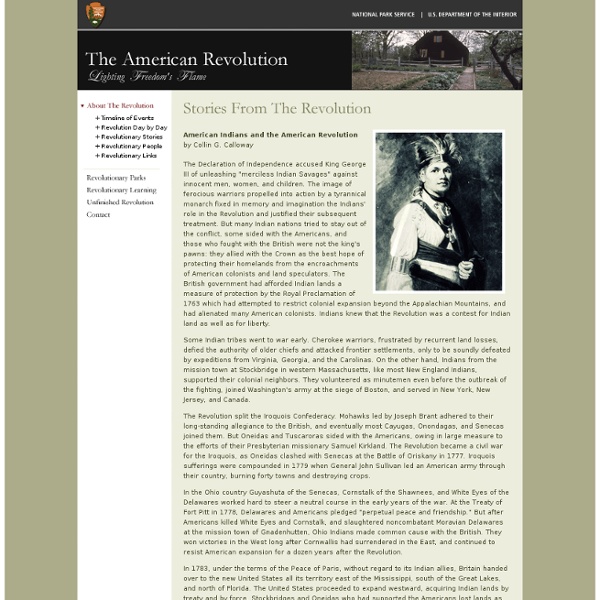The Native Americans' Role in the American Revolution: Choosing Sides
Activity 1. Choosing Sides 1. (Optional) If students did not learn about the Seven Years' War prior to this lesson, it might be a good idea to review the role of the Native Americans in that conflict (see Digital History's The Seven Years' War. It will be helpful also if students have an understanding of the way European control of the land changed after that war. 2. Who may have said this? Once the students provide the answers to those questions, they can speculate on the following: Would you expect that the Native Americans would get involved in the fighting of the American Revolution? 3. 4. 5. Journals of the Continental Congress, Speech to the Six Nations, July 13, 1775 This document, on the EDSITEment-reviewed Avalon Project, is a request made by the Americans to the Iroquois, requesting their neutrality. 6. What were the issues that the various Native American groups were facing? 7. Who was the original source? Activity 2. 1. 2. Joseph Brant in London, 1776: 3.
Indians and the American Revolution
Yet the passions engendered by the American Revolution, despite the good will expressed in the formal policy enunciated by the government, was to lead to bitter and violent confrontations on the frontier. The bloody ground of Kentucky was to be repeated in region after region as the undisciplined and unregulated expansion of the American people got underway. In the end the Indian was the loser. That he would have been a loser even if the King had repressed the rebellion is probable; but his decline would not have been so swift or so bitter. 1. 2. 3. 4. 5. 6. 7. 8. 9. 10. 11. 12. 13. 14. 15. 16. 17. 18. 19. 20. 21. 22. 23. 24. 25. 26. 27. 28. 30. 31.
The Native Americans' Role in the American Revolution: Choosing Sides
Activity 1. Choosing Sides 1. 2. Who may have said this? Once the students provide the answers to those questions, they can speculate on the following: Would you expect that the Native Americans would get involved in the fighting of the American Revolution? 3. 4. 5. Journals of the Continental Congress, Speech to the Six Nations, July 13, 1775 This document, on the EDSITEment-reviewed Avalon Project, is a request made by the Americans to the Iroquois, requesting their neutrality. 6. What were the issues that the various Native American groups were facing? 7. Who was the original source? Activity 2. 1. 2. Students will be asked to consider some of the following questions about the documents: What was the situation that the Mohawks and other Iroquois were facing at the beginning of the conflict? Joseph Brant in London, 1776: Joseph Brant or Thayendanegea, 1783-86 Modeling image interpretation of 1786 Northumberland portrait of Brant: 3. What changes do you notice in his presentation?
Revolutionary Limits: Native Americans
Mohawk Indian Thayendanega, also known as Joseph Brant, served in the British army as an interpreter of native languages during the Revolutionary War. While the previous explorations of African American and white female experience suggest both the gains and limitations produced in the Revolutionary Era, from the perspective of almost all Native Americans the American Revolution was an unmitigated disaster. At the start of the war Patriots worked hard to try and ensure Indian neutrality, for Indians could provide strategic military assistance that might decide the struggle. Gradually, however, it became clear to most native groups, that an independent America posed a far greater threat to their interests and way of life than a continued British presence that restrained American westward expansion. Cherokees and Creeks (among others tribes) in the southern interior and most Iroquois nations in the northern interior provided crucial support to the British war effort.
Sweet Search
Google Scholar
Journals of the Continental Congress - Speech to the Six Nations; July 13, 1775
Journals of the Continental Congress - Speech to the Six Nations; July 13, 1775 The Congress met according to adjournment. The Committee appointed to prepare a speech to the Indians, reported the same. The speech to the Six Nations being read and debated by paragraphs was agreed to and is as follows:- here insert it(1) A Speech to the Six Confederate Nations, Mohawks, Oneidas, Tusscaroras, Onondagas, Cayugas, Senekas, from the Twelve United Colonies, convened in Council at Philadelphia. We, the Delegates from the Twelve United Provinces, viz. Brothers, in our consultation we have judged it proper and necessary to send you this talk, as we are upon the same island, that you may be informed of the reasons of this great council, the situation of our civil constitution, and our disposition towards you our Indian brothers of the Six Nations and their allies. (Three Strings, or a small Belt.) All this time they lived in great friendship with us, and we with them; for we are brothers-one blood.
Colonel Guy Johnson and Karonghyontye (Captain David Hill)
From the Tour: American Portraits of the Late 1700s and Early 1800s Object 8 of 8 The British superintendent of northeastern America's six Indian nations, Guy Johnson commissioned this impressive portrait in 1776 while in London to secure that royal appointment. Sailing from Canada, Johnson must have been accompanied by his close friend Karonghyontye, a Mohawk chief who also went by the English name of David Hill. The alliance between British forces and several Indian tribes seriously threatened the rebel colonists' chances of victory during the Revolutionary War. For this likeness, Benjamin West devised a complex allegory. To signify Johnson's role as ambassador to the Indians, his red-coated uniform is equipped with moccasins, wampum belt, Indian blanket, and Mohawk cap. West claimed that Pennsylvania Indians had taught him to mix paints from berries and clays when he was a child.



